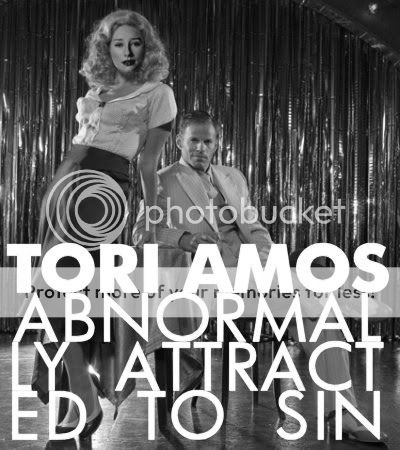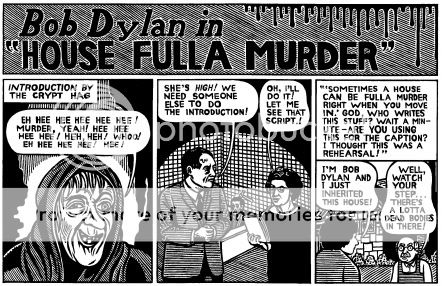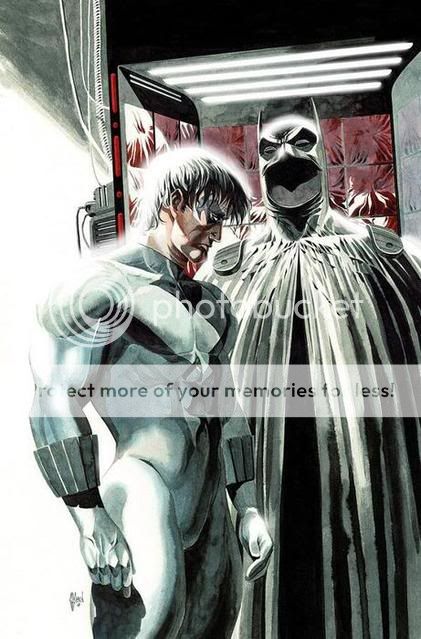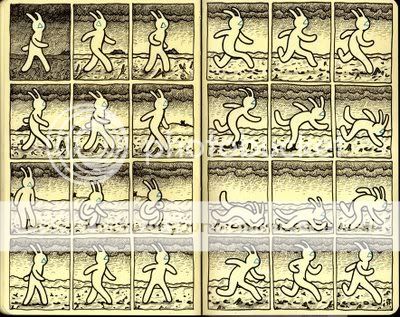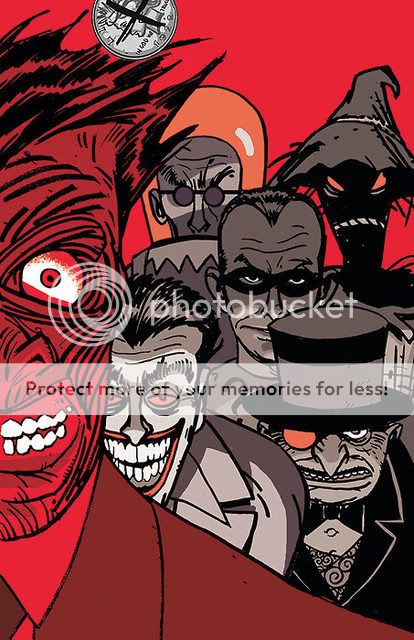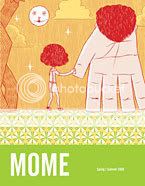
Mome Vol. 4: Spring/Summer 2006
Eric Reynolds & Gary Groth, editors
David B., R. Kikuo Johnson, Jeffrey Brown, Martin Cendreda, Sophie Crumb, Jonathan Bennett, Paul Hornschemeier, Gabrielle Bell, Anders Nilsen, David Heatley, John Pham, Kurt Wolfgang, writers/artists
Fantagraphics, 2006
136 pages
$14.95
Buy it from Fantagraphics
Buy it from Amazon.com
Originally written on July 23, 2006 for publication in The Comics Journal
I wouldn’t want Mome to be any better than it is. See, it’s taken me until the anthology’s fourth installment to realize this, but a goodly sized chunk of its appeal lies in the uneven quality of its contributors. One of the series’ stated goals was to provide readers with a venue in which they could watch a fixed assortment of young cartoonists grow and develop, the implication being that in Mome we could stack up a given creator’s contributions against themselves and see what works and what doesn’t. Maybe it should have been obvious to me–maybe it was to you–but equally inherent in the project’s set-up is the chance it affords us to stack up a given creator’s contributions against another’s. Pitting the great against the deeply so-so in a regularly scheduled cage match is an excellent way to teach readers what does and doesn’t make for good comics–to separate, in other words, a David B. from a Sophie C.
Let’s start with the latter end of the spectrum, then. It’s not that Sophie Crumb’s comics have nothing to recommend them, necessarily; they do have a free-spirited, effortlessly vulgar energy that’s rare in the higher echelons of altcomix these days (though not nearly so much if you step away from the big-name tables at an SPX or MoCCA and sniff through the equally undistinguished punk-rawk comics being churned out by kidz at a Kinko’s near you). It’s just that that’s really all they have. In “Be a Bum,” Crumb rails against the self-obsessed autobio stereotype–in fact, her cri de Coeur of “Don’t spend 10 pages going on and on about taking out the fukin’ garbage!” can only be interpreted as a potshot against fellow Mome contributor Jonathan Bennet, whose previous three offerings have followed a Bennett-esque protagonist as he took photographs, fed pigeons, and (yes) went through someone’s garbage respectively, and whose contribution to Vol. 4, “I Remember Crowning…” replaced the Bennett figure with a bald middle-aged guy but still reads like a parody of indie navel-gazing, the kind of strawman a guy like Scott Kurtz would construct when he gets upset that he can’t follow Jimmy Corrigan. But Crumb lacks the very rudimentary self-awareness necessary to realize that her own endless stories of gutterpunk slumming are just as solipsistic and bereft of larger meaning. Indeed, she touts her own superiority: “I’m too busy having an interesting life, and I don’t take enough time to write and draw!! I am not a bored suburbian loser! My life is so weird and crazy, I wouldn’t know where to start!!” My goodness, how did this salt-of-the-earth wild-woman got to the head of the altcomix class without any external privileges whatsoever? I couldn’t hazard a guess! The pot-kettle comparison is worsened in another of the strips in this volume, where she outdoes Bennett’s most quotidian contributions by recounting a pillow-talk conversation with her boyfriend and a bout of flatulence experienced by their dog. And in her “Smone Bean the Premature Teen,” which can’t seem to decide if it’s a lampoon of America’s sexualization of tweens or a gross-out incest gag comic, she doesn’t even accurately quote Kelis’s “Milkshake”! It’s maddeningly lackadaisical work, right down to the okay art–say what you will about Bennett, but at least that cat can draw.
But a slick line is no guarantor of success, and if Bennett is exhibit A, then Paul Hornshemeier can close the case. His ongoing “Life with Mr. Dangerous,” serialized throughout Mome’s volumes, is as beautifully rendered as any of his work, all bulbous curves and soft corners filled with the kind of perfect, muted colors that’ll land you a consolation-prize Eisner nomination. But. The. Story. Goes. Nowhere. Since it’s about a young woman whose life appears to be going nowhere, maybe that’s the point, but when you tackle a boring situation by creating boring art, the whole is not always greater than the sum of its parts. Martin Cendreda takes an opposite tact: He peppers his “La Brea Woman,” which chronicles a divorced father’s run-of-the-mill day with his young son, with captions imbuing every minor character they meet along the way with a meaning-laden backstory. This doesn’t work either. “Five years from now,” reads the box above the check-out woman at the grocery store, “Valeria’s only son is killed in Iraq.” Groan. (The moonlit concluding shot of the elephant replica is nice, though.) Somewhere in between is Gabrielle Bell, whose examination of a young woman’s lifelong love for a favorite band contains some perceptive moments (“Once I would’ve liked them. Once they would’ve made me cringe. Now I liked them again,” she says of one group) but overall displays the same static figure work and flat-affect tone that’s always left me cold on her comics. In Mome’s realist camp, it’s only R. Kikuo Johnson’s dazzling display of illustrative proficiency (and Louis Riel fandom), “John James Audubon in Pursuit of the Golden Eagle,” that makes an impact, as much from cannily eschewing lit-fic in favor of historical comics and examining man’s relationship with animals (something I’m noticing comics seem to do well) as from the power of the visuals (goddamn).
In the end it’s the surrealists who win the day. They’re led by the great David Heatley, whose lo-fi figure work is perfectly suited to the violent and sexual non sequiturs of the dream comics he contributes; I found myself wishing he didn’t say they were dream comics, though, as the disclaimer undercuts the power of the imagery. Anders Nilsen chips in a photograph-and-comic installation that, he says, served as a sort of rough draft for his graphic novel Dogs & Water, and it’s as alarmingly good as everything I’ve read from him. As with most of his comics, you don’t necessarily know what this collection of blurry landscapes and cut-and-pasted cartoons is about, but you can almost instantly grok what they’re about–I certainly challenge you not to feel a little more lonely and hopeless after reading it than you did before, whether or not you can make heads or tails of it. Somewhat less effective in its randomness is John Pham’s “221 Sycamore Ave.,” another ongoing story being serialized in the anthology. The dreams of its protagonists–a bitter old teacher and his housemate, a ghost of some sort–take the story on a turn for the weird, and while the sharp, blocky shapes that dominate the dream (an underground-manga feel can be detected) provide a memorable contrast with the rest of the tale, the cumulative effect of the two halves is a bit uncertain. More tonally assured is the philosophical horror-comic contribution of Jeffrey Brown, yet another of his hugely rewarding explorations of territory beyond his usual autobio and humor beats. Juxtaposing a Godzilla attack with thought captions like “Everyone is anonymous at the end of things” could be an exercise in irony in other hands, but a few small strokes of Brown’s thick, minimalist inks make it work as they evoke accumulated human endeavor swept away by sudden, thoughtless violence.
Violence is also at the heart of “The Veiled Prophet,” this issue’s contribution from David B. His gifts as a cartoonist and storyteller are so varied and subtle that reading his work is almost an unconscious process. One moment, you’re reading an historical account of an Arab religious cult; the next–without a single seam you can point to and say “right there, that’s where the change took place” you’re reading a horrific fairy tale about tsunami-like armies of corpses and a man whose face no one can look at and live. Throughout, insights into human nature–the link between religious fervor, tyranny, and sexual mania; the sinking feeling that defeat at the hands of such forces is inevitable–shine through like a searing peak through the prophet’s veil. B. doesn’t so much draw as weave–threading together spears, skeletons, strands of cloth, naked bodies to create panels whose indelibility as stand-alone images (nearly any one of them could have been isolated for the volume’s cover) is actually surpassed by their cumulative effect.
Basically, the guy is a genius.
Which is part of why putting B. in the anthology always seemed an odd choice. Not only is he older and from a different linguistic background than most of the other contributors, but he’s also so freaking good that putting him amongst up-and-comers (even the really good ones) feels almost like bullying. But perhaps the message sent by his membership in Mome is an important one: Whatever the qualitative differences between a David B. and a Sophie Crumb might be, they are both doing the same thing–making comics. With that in mind, both readers and the creators themselves have every right to demand that the work of the latter class live up to that of the former.




